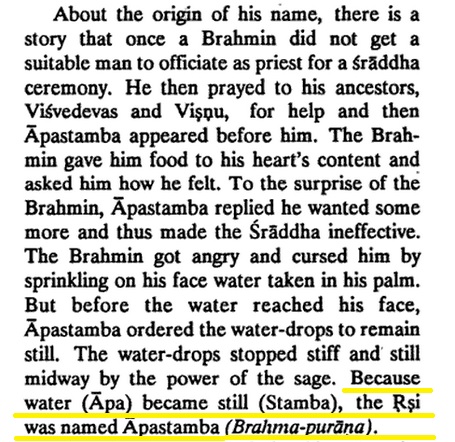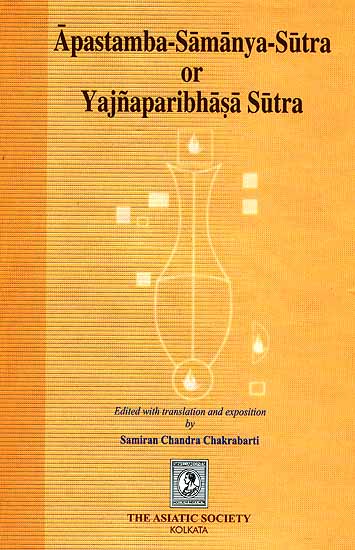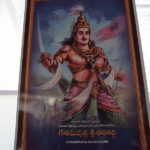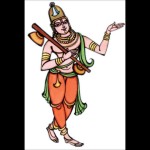The Next installment in our series on Dharmic Personalities from Andhra is the all-India figure known as Apastamba.
Background
Apastamba muni was a great Sutrakaara who compiled the Apastamba Kalpasutra. He was born in the lineage of Maharishi Bhrgu, and belonged to the Taittiriya Sakha of the Krishna Yajur Veda. His wife was the pativrata Aksasutraa and his son was Karki. [1]
He is said to have lived somewhere in the Godavari valley of Andhra. There is an interesting story behind the word ‘Apastamba’. Although the origin might be in reference to another Pauranic Apastamba, it is also attributed to the sutrakaara as well.
Tradition holds that Apastamba, along with Baudhayana muni, was one of the two early Dharmashastra writers from Andhra. This has been adumbrated by both traditional and foreign academic sources. Interestingly enough, per Apastamba himself, the tradition asserts that Rishis are not born in the Kali Age, though individuals may often display some of their characteristics. It demonstrates the importance of referring back to the Purvacharyas, as Apastamba does by example. It further cements his connection to the present age. The current academic paradigm dates him to 300 BCE, though he is likely much older.
Dharmasutras originated from Grihyasutras, which are the second class of text (the other being Srautasutras) that stem from a category known as Kalpasutras (meaning thread on rituals, whether daily (nithya) or special (naimittika)). While Srauta deals with sacrificial rites, and Grihyasutras deal with domestic rites. Dharmasutras are more general and societal in nature.
Much has been written about the Dharmashastra and its auteurs by the Western Academe. Nevertheless, the best starting point to understanding a civilization is through the internal logic respected by its native scholars. In the case of the four main Dharmasutras (Vasishta, Gautama, Baudhayana, and Apastamba), such considerations matter particularly for chronology as it has become fashionable to say Apastamba preceded Maharishi Vasishta (the Saptarishi who featured in the Ramayana)—a notion that would send even traditional Dharmic schoolchildren into peals of laughter. In fact the order is reversed, with Sage Vasishta being the eldest and Apastamba the most recent and most preferred for the Kali Yuga (the present Age). This aligns with the finding that Baudhayana muni was the son of Maharishi Kanva (from the fourth paada of the Dvapara Yuga). This makes the correct Dharmasutra order: Vasishta, Gautama, Baudhayana, and Apastamba.
Thus, Apastamba’s Dharmasutra is in turn a portion of the expansive and eponymous Kalpasutra, which is additionally divided into the Srautasutra, Grihyasutra, and Sulbasutra.
The Sulbasutras are treatises on geometry as required for Vedic rites and requirements (such as the construction of fire-altars, etc.). Apastamba himself belonged to the Krishna (Black) Yajurveda), and expounded upon the intricacies of these altars. The result is even though the focus was on Dharma and Yagna, quite a bit of Mathematics was compiled as well. But to understand the place of these, one must examine the Kalpasutra corpus as a whole.
Achievements
- The Apastamba Kalpa sutra consists of 30 prasnas. The first 24 prasnas (books) focus on Srauta (Vedic Yagna)
- The 25th is Apastambeeya-mantra-paata, which deals with definitions & ritual prayers (hautraka). It also has a key section that has important ramifications: Paribhashas (general rules of interpretation for the Kalpasutras)
- The Apastamba Grihya-sutras are contained in the 26th and 27th books.
- The 28th and 29th together make up the Apastamba Dharmasutra (which is sub-divided into 8 patalas and 23 parts. The 30th prasna is focused on Sulba Sutra.
- He is also credited with the Apastamba-brahmana, Apastambopanisad, Apastamba-prayoga, Apastambaapara-sutra, and Apastamba-smriti
- The Apastamba-smriti consists of 207 slokas
Apastamba is seen as one of the authorities who emphasised the notion of Yuga Dharma vs Sanatana Dharma. “The theological explanation is that the people of those days had extraordinary [spiritual] power lacking in modern men….the dharma appropriate for ancient ages may be inappropriate for the current depraved age” [2].
What is notable about his Dharmasutra is the specification of the importance of accepted custom (samay-acarika). Rather than a one-size fits all implementation of Vedic Dharma, he wrote that the native customs of a community or region apply, so long as they don’t conflict with explicit Vedic injunctions.
This explains Apastamba’s divergence from Vasishta, Gautama, and Baudhayana on matters specifically on sexual morality, ranging from polygamy to niyoga. He explicitly favors monogamy, “forbidding the taking of a second wife if the first is able to participate in ritual activities and bear children” and prohibits niyoga (levirate) in the Kali Age.
He also asserted the role of women as upholders of dharma. He therefore specifies the importance of children learning much lore and custom from Women. Apastamba also protected the rights of women by forbidding their abandonment by husbands. He also specified that a wife may use the family wealth on her own while her husband was away (unremarkable for our time perhaps, but certainly far ahead of what is thought of as the traditional view).
He is also considered the originator of the principle distinguishing between “explicit vedic texts” (pratyaksa sruti) and “inferred vedic texts” (anumita sruti). This provided the epistemological basis for custom among righteous people stemming from the Vedas as well. There were also commentaries written on his work, by the scholar Haradatta, and of course, Kumarila Bhatta and Adi Sankaracharya.
In tandem with his work on Dharma are his ancillary achievements in Mathematics and Engineering.
Mathematics
- Construction of the Square
- The Theorem of the Square on the Diagonal (restatement of Baudhayana Theorem)
- A precise value of the Square Root of 2.
Apastamba’s contribution to Maths is well known. Correspondingly, although the motivating drive for his Sulba Sutra was to provide guidance for construction of fire altars, there were a number of Mathematical, Astronomical, and even Engineering externalities as well.
His key accomplishments have been quickly summarised above, though are best discussed in a Series of articles on Sulba.
Legacy
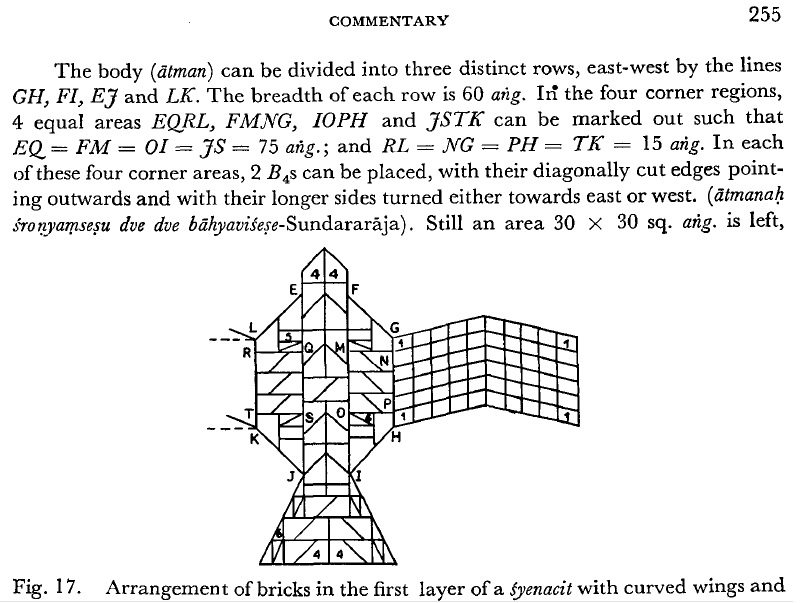
Akrodho-aharsho-arosho-alobho-amoho-adambho-adrohah satyavachanam-anatyaasho-apaishunam-anasooyaa samvibhaagas-tyaaga aarjavam maardavam shamo dhamah sarva-bhoothair-avirodho yoga aaryam-aanrshamsam thushtir ithi sarva-ashramaanam samaya-padhaani thaany anuthishtan-vidhinaa sarvagaami bhavathi || 1.23.6
“Refraining from anger, excitement, rage, greed, perplexity, hypocrisy, and malice; speaking the truth; refraining from overeating, calumny, and envy; sharing, liberality, rectitude, gentleness, tranquillity, self-control, amity with all creatures, Yoga, Aarya-like conduct, benevolence, and contentment—there is agreement that these apply to all orders of life. By practicing them according to the rules, a man attains the Supreme Being.” [2, 61]
From religion and rite to mathematics and astronomy to most important of all, Dharma itself, Apastamba’s all-India legacy is undeniable.
Ill-informed or ill-intentioned critics have often scoffed that the Dharmasutras (including Apastamba’s) are “boring texts for Brahmins and their rituals“. But this is unfair. While it is true that a voluminous portion of them is dedicated to the difficult rituals and injunctions that characterised a Vaidika Brahmana’s life, the are many passages directed towards the benefit of not only the other three varnas (Kshatriya, Vaishya, and Sudra) but also society in general as well. This denotes the importance of people not only avoiding tunnel-vision about their own lifestyle and seeking to impose it or hold it above others, but to recognise the need for balance and respect for the individual work of all members of society.
“Dharma is undoubtedly the most central and ubiquitous concept in the whole of Indian civilization.” [2]
Some colonial (and neo-colonial) scholars have either downplayed the existence of formal law in Ancient India or have said that Dharma replaced law. But neither is correct. Ancient India stressed the importance of both formal Law (Vyavahara) & Dharma (Righteousness), the problem is such “scholars” have understood the purpose of neither, as well as the necessary connection between the two. There is a famous Chinese proverb that “Laws control the lesser man. Right conduct controls the greater one.” Thus, law exists as a baseline for society that holds baser men, women, and criminals (of all classes) accountable; where as Dharma inspires and holds the upright man (of all castes) accountable.
Law is the common minimum or floor for society while Dharma (in its highest form) is the ceiling we must aspire toward.
“It’s dharma that provides the guidelines for proper and productive living and for social organization and interaction. It includes social institutions such as marriage, adoption, inheritance, social contracts, judicial procedure, and punishment of crimes, as well as private activities, such as toilet, bathing, brushing the teeth, food and eating, sexual conduct, and etiquette“. [2]
“It is difficult to gain mastery of dharma by means of scriptures alone, but by acting according to the markers one can master it“. (A.2.29.13-14) [2]
Apastamba is also notable for writing that after learning Vedic knowledge, those initiated in the Vedas can then understand final knowledge possessed by women and Sudras. The meaning here is that once Vedic knowledge is mastered, the value and divinity of everyday knowledge possessed by uninitiates is then understood as well. Although the rights to Vedic ritual and ritual recitation belong to Brahmanas, the dvija (initiate classes) include Kshatriyas and Vaisyas as well. What those murkhapanditas seeking to impute “beef in vedas” meanings into Dharmasutra as well forget, is that manuscripts are manipulated. In fact, while one phrase is read as prohibiting initiation to sudras, the same sloka prohibits initiation to criminals of any caste. Further, some have argued that the correct interpretation of the sloka (due to a contested word change) actually means that meritorious Sudras with good guna may be initiated as well. While this is not to assert what is Apastamba’s position one way or another, it does demonstrate the distinguishment (viveka) between right and wrong required to even interpret these texts.
Finally, for those concerned about casteism, here is what Apastamba wrote, and incidentally, it would be something echoed by Annamacharya thousands of years later:
Atmanan-pasyan-sarva-bhootaani na mohyacchinthayankavih |
Aatmaanam chaiva sarvatra yah pashyetsa vai brahmaa naakaprushte viraajathi || 1.23.1
Seeing all beings in himself, a wise man thinks about it and is not perplexed.
A Brahmin who sees himself in all beings, likewise, shines forth in the vault of heaven. [2, 61]
References:
- Garg, Ganga Ram. Encyclopaedia of the Hindu World. Vol 2. New Delhi: Concept Publ. 1992. p.552
- Olivelle, Patrick. Dharmasutras: The Law Codes of Apastambha, Gautama, Baudayana, and Vasistha. Motilal Banarsidass. 2000
- Buhler, Georg. The Sacred Laws. Oxford: Clarendon Press. 1897
- Sen, S.N. & A.K. Bag. The Sulba Sutras. New Delhi. Indian National Science Academy. 1983. p.234
- http://www.thehindu.com/br/2005/03/22/stories/2005032200241700.htm

